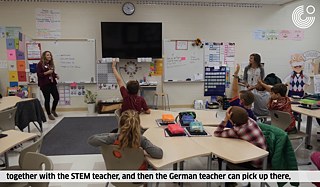The goal of CLIL is to acquire knowledge in specific subject areas with the help of language. The Kinderuni lectures can be integrated into CLIL instruction as supplemental material. German language lessons can be used as language preparation for CLIL lessons.
What is CLIL?
CLIL (content and language integrated learning) is becoming increasingly influential in foreign language instruction. Many schools in central and western Europe have taken up the ideas coming from this type of foreign language learning and have introduced CLIL instruction.
There are three main arguments for this; first, the empirical-experimental method in many subjects, in particular in the sciences, which is also of great value in acquiring a foreign language and leads to similar learning processes; second, learning another language in an authentic context with content that is immediately applicable; and third, the opportunity to associate the spoken language with concrete and definable examples and processes.
CLIL does not just improve students’ success in learning a foreign language, it develops, generally speaking, learners’ ability to communicate and carry out discussions. This is an important prerequisite for success in the world of work or in a course of study.
Introducing CLIL instruction does not require a new curriculum at first. Small project modules in a certain subject area are a good entry point.
The 10 principles of CLIL emphasize this.
- Bilingual subject matter instruction represents a new school subject, because elements (which are already present) are combined and thereby form a new way of transmitting and acquiring knowledge and skills.
- Bilingual subject matter instruction, due to its complex requirements, is a prime example of the new methodical-didactic approaches in education, such as action-oriented and learner-centered learning, as well as learner autonomy.
- In bilingual subject matter instruction, subject-oriented learning takes place in the language and using the language as one organic whole. Thus, a cycle of “language learning, observation, testing, application, generation, and awareness-building” occurs, which takes place repeatedly on both a small and a large scale.
- Conventional foreign-language instruction leads in general to everyday communication abilities (basic interpersonal communication skills, or BICS), whereas bilingual subject-oriented instruction leads to the ability to express complex thought processes (cognitive academic language proficiency, or CALP). In addition, students develop discursive skills pertaining to specific content material. Bilingual learning therefore leads to key competencies.
- Two different sets of learning objectives are not needed for subjects taught bilingually. The subject matter instruction is given primary importance and in turn drives the learning objectives.
- The hard sciences, math, computer science, and technology are particularly suitable for bilingual instruction, for one because both the subject matter and the language are inherently empirical-experimental and thus lead to analogous learning methods; secondly, the other language is acquired in an authentic context with immediately applicable content; and thirdly, language work can be associated to a high degree with concrete and describable objects and processes.
- Bilingual subject matter instruction requires cooperative work. It is therefore well designed for project work.
- Bilingual learning is not limited to formally institutionalized forms; it can also be encouraged outside the classroom, i.e. in projects across subject areas.
- Bilingual learning can “take place” in a variety of levels of development, ranging from small, theme-based, multi-week project modules in one subject, to learning-objective-focused half-year or year-long theme cycles of a more comprehensive nature, to incorporation into curricula, and further still the permanent integration into education over the course of multiple years.
- Bilingual learning can begin as early as kindergarten and preschool (in playful ways, of course), can continue in primary school, and then, taking advantage of the full development potential offered by secondary education, extend into its fully developed form.
For more, visit
www.goethe.de/clil





